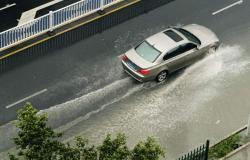The situation in Slănic, Prahova county, is reminiscent of one of the biggest landslides. It all happened in 2010, in Ocna Mureș, when the mining galleries collapsed, endangering dozens of homes.
The landslides were caused by water seeping into some abandoned mine galleries. Shortly after the event, two homes were evacuated from the area, and a supermarket located near the crater, formed by the surprise of a mining gallery, collapsed, the resistance structure being affected.
Ten-meter crater in the center of Ocna Mureș
The crater created by the collapse of the gallery is about ten meters in diameter. The mayor of Ocna Mureș at that time declared that no one was injured as a result of the landslide.
“The people at the salt mine told me it’s a vertical collapse and it’s not over a large area. The supermarket fell on an area of 3,000 square meters… The world is still prepared for evacuation. There is no damaged house”, says the mayor of the locality at that time.
“The phenomenon is due to water under pressure coming from a well belonging to SC Salina RA, which reached the surface. The probe is at a distance of about 100 meters, and the crater is about ten meters from the store”, relayed those from ISU Alba.
“The causes were the evolution over time of salt exploitation, to which are added the incidents that took place in recent years at two wells, as a result of which fresh water, brine and fluidizing liquid, respectively diesel, infiltrated into the soil it is used in the exploitation process in Ocna Mureș.
Another important cause of the phenomenon was the pressure exerted on the underground galleries, from which brine is extracted”, the specialists also explained the collapse of the earth in December 2010.
The first catastrophe occurred in 1912
In 1912, a first major catastrophe occurred. The waters of Mureș came out of the bed and entered some of the old mines, causing their ceilings to collapse. As a result, craters and pits of considerable size appeared on the surface of the land, also affecting the inhabited areas in the vicinity.
In 1952, it was decided to fill all the caverns and craters formed above the former Roman, Iosif, Francisc, Ferdinand, Queen Maria and Prince Nicolae galleries with concentrated brine, in order to prevent the expansion of the old mine collapses.
However, in 1954, disaster struck. Through the accidental drilling at the level of the horizon – 100 meters of the 6 Martie mine, together with the lake formed by the collapse of the neighboring Iosif mine, the water of the lake flooded the 6 Martie mine, which was definitively abandoned.
In 1978, the work of exploiting solid state salt in Ocna Mureș was stopped
In 1978, the separation pillar between the 1 Mai mine and Lake Iosif (at the -90 meter level) gave way, and the waters poured into the mine chambers, completely flooding it in just a few minutes.
The miners on that shift managed to save themselves, coming to the surface on the steps of the ventilation shaft.
This mining catastrophe led to the definitive stop of the exploitation of solid salt at Ocna Mureș, after decades of almost uninterrupted activity, according to Adevărul.
Tags: Ocna Mures landslides hit city
-




